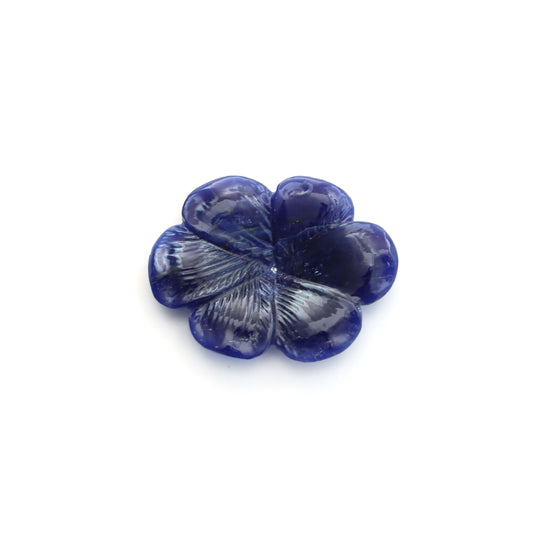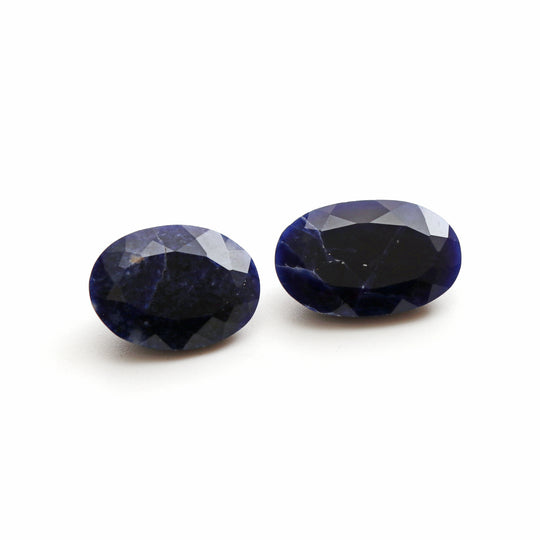What is Sodalite Gemstone?
Sodalite is a blue mineral that is commonly used as a gemstone. It is known for its deep blue color and white veins, and is sometimes referred to as "poetic sapphire". It is also believed to have metaphysical properties, such as enhancing communication and promoting peace and harmony.
Sodalite Gemstones
National Facets
£35.00
£38.00
What are the types of Sodalite Gemstone?
The gemstone known as sodalite belongs to the sodalite mineral group, which includes haüyne, lazurite, and nosean. All typically blue sodalite gemstone, these minerals are actually found in lapis lazuli.
What are the properties of Sodalite Gemstone?
Sodalite Gemstone Properties
Sodalite Metaphysical Properties
Sodalite gemstone beads is sometimes considered a guardian for heroes and heroines, especially those speaking truth to power. It's believed to have the ability to unite logic with intuition and the drive for truth with the rise of idealism. Practitioners have used sodalite to organize the mind, as it's said to promote rational thought, objectivity and perception. Sodalite Gemstone benefits in cleansing lymph nodes and boost the immune system. All these balancing abilities are why sodalite is often used in groups with other stones and among multiple users.
Sodalite Physical Properties
Sodalite color is usually blue to blue-violet in color and found with nepheline and other feldspathoid minerals. It is usually translucent, with a vitreous luster, and has a Mohs hardness of 5.5 to 6.
Sodalite often has white veining, and it can be confused with lapis lazuli. Small amounts of sodalite are present in many specimens of lapis lazuli. If significant pyrite is present, the specimen is not sodalite.
Where does Sodalite Gemstone come from?
Sodalite deposits are found in Afghanistan, Brazil, Greenland and Canada, as well as in Maine and Arkansas within the United States.
What color is Sodalite Gemstone?
While blue (with white inclusions) is the most common color of sodalite, this stone can also be found in other colors like black sodalite, white sodalite , green sodalite, red sodalite, and pink sodalite. Sodalite fluoresces orange sodalite under ultraviolet light, except for Hackmanite. That variant displays tenebrescence instead, becoming deeper and richer in color after UV exposure (although the effect fades after time).
Where to buy Sodalite Gemstone?
You can buy solidate natural gemstones from various sources, such as:
- Jewelry stores
- Online gemstone retailers
- Gem and mineral shows
- Wholesale rubellite garnet
- Beads Wholesaler
Among enormous sources available for solidate gemstones for sale, be sure to buy online solidate gemstone from reputable sellers to check the quality and authenticity to ensure that it is genuine stones.
At National Facets, we strive to produce the finest quality of beautiful gemstones. We offer a wide variety of premium-quality Natural Gemstones on the internet.
Frequently Asked Questions
Q: Is sodalite a real gemstone?
A: Yes, sodalite is a real gemstone. It is a semiprecious mineral that is commonly used in jewelry and decorative items. It is known for its rich blue color and white veining, and is often used as a substitute for more expensive gems like lapis lazuli. While not as widely known as some other gems, sodalite is still valued for its beauty and versatility, and can make a beautiful addition to any collection.
Q: Is sodalite a rare stone?
A: Sodalite beads is considered to be a relatively uncommon gemstone, but it is not considered to be rare. It is found in several locations around the world, including Canada, Brazil, Norway, and India, and can be easily obtained for use in jewelry and other decorative items. However, the high-quality, deep blue specimens with well-defined white veins are less common and may command a higher price. Overall, sodalite is considered to be a semi-precious stone and is valued for its beauty and versatility.
Q: What is the best color of sodalite?
A: The best color of sodalite is typically considered to be a deep, rich blue with well-defined white veins. High-quality specimens with this coloration are considered to be the most desirable and can command a premium price. However, personal preference plays a large role in determining the "best" color of any gemstone, and some people may prefer lighter or more uniform sodalite blue color shades. Ultimately, the best color of sodalite is the one that appeals most to the individual buyer.
Q: How can you tell if sodalite is real?
A: There are several methods to determine if sodalite is real, including the following:
Visual inspection: Real sodalite should have a rich blue sodalite color with white veining. If the stone has a pale or washed-out color, it may not be genuine.
Specific gravity test: Sodalite has a specific gravity of 2.3-2.4. This can be measured using a gemological scale.
UV light test: Real sodalite should fluoresce a blue-white color under long-wave ultraviolet light.
Acid test: Real sodalite is insoluble in acid. To test, you can apply a drop of hydrochloric acid to the stone. If it dissolves, the stone is not genuine.
Expert appraisal: A gemologist or other trained professional can examine the stone and use a combination of tests to determine if it is real.
Q: Does sodalite glow in sunlight?
A: Sodalite can reflect light in a way that gives it a bright and eye-catching appearance, especially in sunlight. The deep blue color of high-quality specimens can be particularly striking, and the white veining can add interest and contrast. Overall, while sodalite may not glow in the same way as some other gems, it is still prized for its beauty and versatility.
Q: Where is sodalite used?
A: Benefits of sodalite gemstone
- It supports communication.
- It enhances intuition.
- It encourages truth.
- It boosts confidence.
- It corresponds to the third-eye chakra.
- Helps overcome negative thinking.
- It increases mental clarity.


